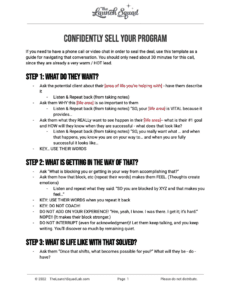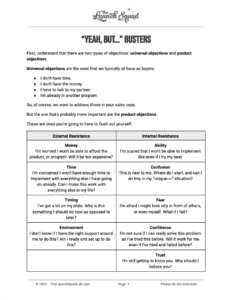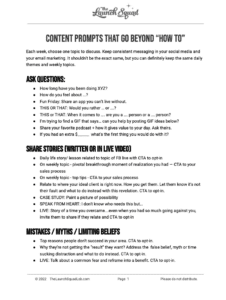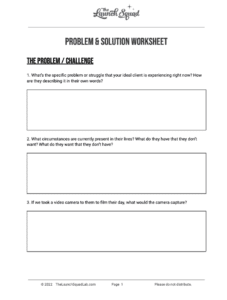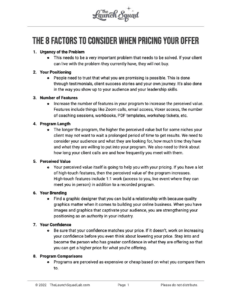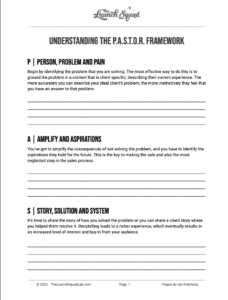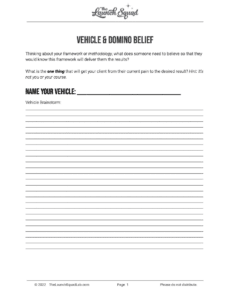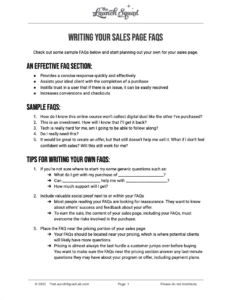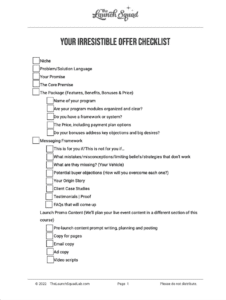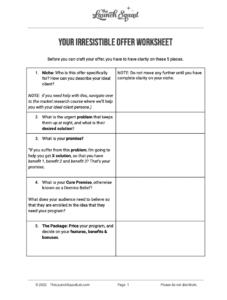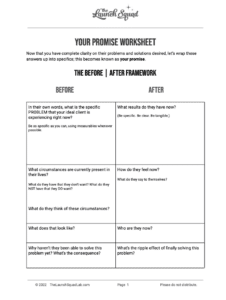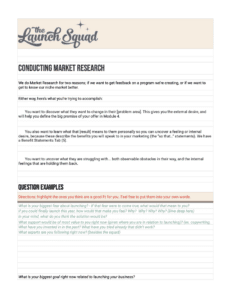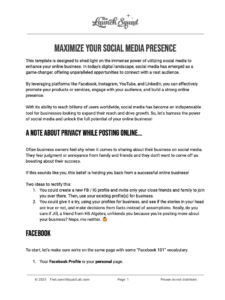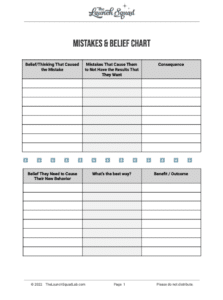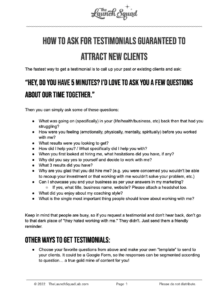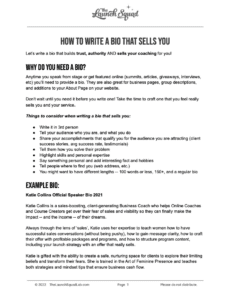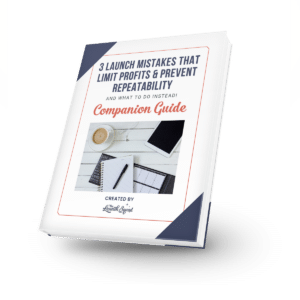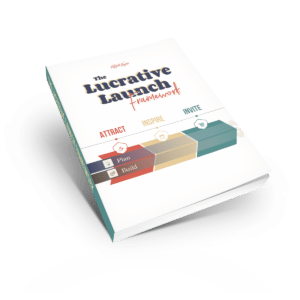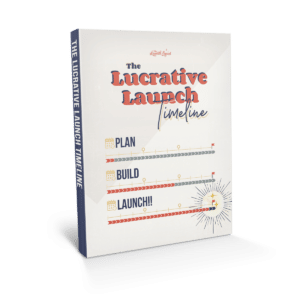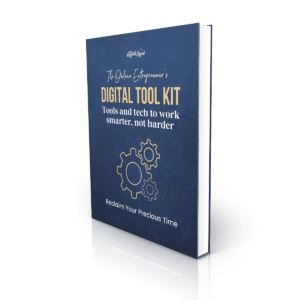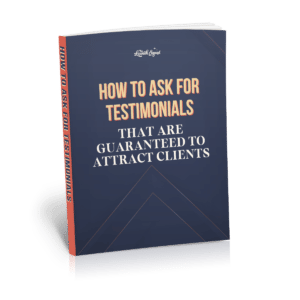Have you ever thought, “I know I need to launch my program, but where do I even start?”
Launching can definitely be overwhelming, but did you know that a single, well-executed launch can sometimes bring in an entire year’s salary?
A launch is an incredibly powerful tool for an online business.
But what goes into a launch? What are all the moving parts of a launch?
What type of launch should you do? A webinar, live launch, challenge, or hybrid?
And the EMAILS!! Allllllllll the emails. What email gets sent when? And who on earth is going to write them?!
Launching definitely isn’t for the faint of heart. It takes work and preparation. It takes content, writing, and communication strategies. It takes understanding the buyers’ journey, both logically and emotionally.
But a well received launch makes it all worth it!
In our recent podcast episode, we break it down into some bite-size chunks to make it easy to understand.
Jeffrey: Welcome to the lightened, your launch podcast. Today, we're talking about the anatomy of a launch and all the things that go into it. Stay tuned.
Announcer: Hey, we're in the Launch Squad and this is the Light Your Launch podcast. We teach coaches and course creators how to lighten their launches. We're bringing you all of the tips and strategies to take your launch from intimidating to money-making. In this podcast, we talk about everything; the sales, strategy, mindset, technical and spiritual aspects of running your best launch ever. So if you're feeling overwhelmed and unsure of the next right step, we're here to bring clarity, confidence, and excitement into your next launch. This is the Light Your Launch podcast. [inaudible]
Jeffrey: Welcome back to the show. I am Jeffrey. [inaudible] the funnel master of the group. I'm back again with Katie Collins, our sales superhero. And today we're talking about all the things that go into a launch. We're talking about the anatomy of a launch, all the moving pieces, all the things that give you so much confusion and grief. So Carrie Katie, where, where do we begin with the launch? What are we going to start out with?
Katie: You're making it sound super fun with confusion and grief. We promise it can be super energizing, especially if you are well-prepared. So that's what we're going to we're talking about today is really the preparation so that your launch goes off without a hitch. We hope
Jeffrey: That's a perfect distinction, uh, because when you are prepared, it is not as overwhelming. It's not so full of grief.
Katie: Right? Right. So one of the things that we talk about all the time in the launch squad is you always want to start with your offer in mind, any time you're going to get yourself out there and market in some way. And that's what a launch is, right? It's a marketing campaign. If you will, with a certain container of time, you always want to know, well, what the heck is the offer at the end? So if you're choosing to dive in without the offer, stop right there, screech stop it exactly. And figure out what your offer is first. So what do I mean by your offer? It goes beyond just the program, you know, you may say, well, my offer is, you know, um, I don't know, crafting an irresistible offer that sells for example, that's okay. Hey, what a great name. Right? So that, that was our offer. And, um, but it's more than that because inside your offer is the program as well, bonuses and, you know, messaging around how to overcome people's objections. You might have, you know, additional kind of things that you bundle together. Um, so it's just a bigger answer than just the program itself. So not to go too far Down the path, what the heck is an offer. We have a program for that. Yeah.
Katie: Um, but so number one, you've got to start with your offer. And then from there you get to decide why, what type of launch do you want to do? And there are different types of launches out there. Um, some people choose to just do a webinar or they call it a masterclass, but it's a single event that might be 60 to 90 minutes long with an offer at the end. And that works well for low ticket things, under a thousand dollars. Uh, other people choose the live launch method. And I believe that was first coined by Kelly Roach. Um, and she has her whole system where you are live in your Facebook group, nine days in a row. Other people like to do a five day challenge or they'll play with the number five day, three day, 28 day. Um, and you know, but you're, you're delivering that content over email in that case.
Katie: And you may also have a Facebook group to gather your, your folks and you can also choose a hybrid of any or all of those. And that's the type of launch that we recommend is where you're delivering a challenge. And so that you're capturing, um, your folks in email, and then you're also going live every day to support, um, the content of the challenge. And that's in your Facebook group. And then at the end of the week, you're inviting the challenge participants to go to your webinar or masterclass. And that's where you would make your offer so slightly different than the live launch method in which they make the offer on the live. Um, we do it a little bit different. So you get to decide which launch you want to try. And then when you decide the type of launch, then you need to pick your dates.
Katie: And so it's backwards mapping, like when does the program start? Okay. Then my launch is probably going to end probably 14 days before the start date of the program. And that allows you time to get your, your ducks in a row. And it also allows your buyers time to sort out their schedule and kind of get ready for this. If you try to offer it too soon, you'll find that the objection of, you know, my calendar is already booked will come up. So you really want to give them plenty of space for that. And a quick tit tidbit here, um, is the longer you're asking them to wait between the purchase point and the start date. The more ways you need to get them to get started right away. You don't want there to be a lull because that increases the chance of a refund requests.
Katie: You know, what did I buy? I'm waiting around, they're bored. They were excited. And now you've just kind of extinguished the flame here. So you've got to have, and a lot of times your bonuses can address that you don't get started right away with these bonuses that will take you time, that you don't need my feedback on or do it. And then when we start the class, I'll give you my feedback immediately. Right. But just give them something to do. Um, and so, so that is the starting point of how to launch is the offer, and then what you're going to do to launch it and pick your dates. Right. Then, then we get into the really fun stuff, which is where my tech guy comes in.
Jeffrey: So now that we're talking about, you know, the launch, there's a technical side to this. So let's, let's breeze over this a little bit. Um, so what are some of the technology things, and I'll try to be platform agnostic here. These are just the pieces that belong in your launch. And, and we're going to start with, of course, since we're starting with the offer, right? One of the things we always start out with to solidify and to make sure is in place is a checkout process. And this is usually a, some kind of cart system and some kind of payment gateway. This makes sure that the functionality for putting a link or button or checkout form on your pages is, is available. And when somebody fills that in and says, yes, I am in that money gets into your bank priority. Number one, let's just start there, right?
Jeffrey: The next thing you need, and this kind of goes back to where, where are you going to put the checkout process? Right? Well, you need pages. You need some sort of online page builder, whether it's WordPress, Kajabi Kartra or something else, you need pages. You need a place where you can build and manage, uh, uh, online pages somewhere to put the opt-in forms, for example, which is actually next, what else do you need? Opt-in forms. People are, you need a way for people to opt into your launch, whether it's a webinar, then you need a webinar opt in. If it's a live launch, then you're probably inviting them and getting them on your list so that you can email them. Same thing with the challenge and all of the things that there's usually a trigger that gets them into the process. And that's usually an opt-in form.
Jeffrey: Um, now when we're talking about the hybrids, the challenge is the live launch webinars, whatever there's some variable tech platforms here. So depending on the kind of launch you want to do, you may end up using something like Facebook. Uh, perhaps you use Facebook to do the live launch or deliver a challenge, um, or zoom, you might need zoom or some other webinar platform, uh, to deliver a masterclass or webinar. Uh, on that note, you might need slides. So keynote, power, PowerPoint, Google slides, you might be delivering that as well. Um, you also may need a booking calendar app if you're doing high ticket things or, or, you know, you need that other, uh, additional contact with people to get kind of that one-on-one, um, sales connection. Uh, then you might need a booking calendar and also maybe a screen recorder, maybe, maybe you're recording your screen and your slides and all that. Um, but that's pretty much like the basic technology part and just to touch on the opt-in forms, uh, those should bring your audience into your email list. And that's kind of next on the, on the list here, which is email,
Katie: Right? You know, um, I love Bridget Brady says it best. She's a social media expert. And she's saying, you know, the whole purpose of social media is to get them off of social media. Um, so, you know, anytime you're building, um, an audience on social, you don't own that audience. And if you were to ever get banned or set in some way, you know, got kicked off their, their platform, you lose your entire audience. So you really want to make sure that people have to opt in through an email so that you own your audience and you can continuously connect with them, whether they choose to continue with this launch that you're in or join it again. So, um, emails are so vital. And of course, you know, when you're thinking about your offer and your webinar and just all the content related to the launch, right?
Katie: We're also thinking about the content related to the emails and they should really tell a story. And the, and it's backwards mapping right from like, where are they right before you make the offer? Where's their mindset. And where's their mindset before they say yes to the challenge, for example, and where's their mindset before they say yes to your free gift that got them into your funnel. And when you understand, and you're very clear on their mindset in those places, then your copy is going to reflect that. And it truly takes them on this client journey. Um, now not to overwhelm you, but you're going to write a ton of emails. That's the technical term. Yes. In the launch squad, that's the chapter in the book, you, right. You're a ton of emails. Um, but you know, just to, to break down what, what emails and it's not to overwhelm you, but it's just to take it one project at a time.
Katie: If you're going to deliver a free gift, if you're going to have an opt-in. And that's usually how we gather leads in the beginning, then you'll want to have emails that are a sequence for that free gift. So the first one is the delivery email. The second one is like a welcome to my community. Here's what to expect email. And then the next ones are leading them to your next call to action, whether that's book a call with me or whatever other thing, and it might be leading them directly into the challenge. The thing with that is you have to be careful to update that email sequence after the challenge. So you're not inviting them to something that started in January when now it's March. So you've got to keep on top of these things. Um, but that's one email sequence. And then another email sequence is when they say yes to opting into whatever launch you've put on.
Katie: So in, in our example, we recommend the hybrid launch of the challenge with a webinar at the end and, um, a Facebook group where we go live every day to support that challenge. Um, but the reason we're doing that is because it's just about 30 to 35% of the folks that register will actually join your Facebook group. So this hybrid approach allows us to still reach the people that don't want to join your Facebook group. Um, so again, that's, that's why we do that. So you're going to need an email sequence to welcome them into whatever they registered for. So again, it's, you're in congratulations, pop the champagne, right? Throw the confetti, like get them all excited, um, and tell them what to expect and what are their next steps. Um, if there are links, you know, put the links in there, here's how you join me or here's what to expect.
Katie: You'll get emails over the next five days. We start on Monday. So dates and that kind of thing. And then you're going to need an email sequence when they decide to participate in your masterclass or your webinar. And so again, it's, you know, you're in, let me remind you what you're going to learn here are the links that you need. And then of course, reminder sequences, Hey, we're getting started tomorrow. Don't forget, you know, click, click here to add it to your calendar. We get started, you know, it's happening today, it's happening in one hour, it's happening in 15 minutes. We're starting now. Now you may not choose to send all of those, but that is in fact what a lot of people do. And it's, it's up to you
Jeffrey: And Katie, what would you say the reason for those are,
Katie: I was going to say, it's truly up to your it's up to your audience. Right. But, um, but truly, I don't know about you, but when I am free and I see that email that says, we're starting now, I'm like, Oh, I'm actually free right now. But you know, if you're looking at like a 13% open rate, which is, you know, the average, these days, anywhere from 13 to 20%, and you only send one reminder, email, only 13% of your list is going to see that. Yeah, if you send four reminder emails, then you're guaranteed to perhaps show a different 13% each time. Right. So it does increase the chances that you're going to have a bigger audience. And that's what you truly want is a bigger audience at your event. Right? So it's really important to remind people and just remember that there are people out there that get annoyed by it. And there are people out there that are so grateful that you keep reminding them because they really want to go and they need that. So what you're doing is helping you're talking to the people who want that and the people who get offended by it, let them go, okay,
Jeffrey: They're probably not your clients, right?
Katie: Yeah. If they're annoyed by being reminded about a very exciting and informative event that you've been planning months for
Jeffrey: Something, something. Yeah. Here's, and here's the thing like this really comes back to that audience idea, like your target market, your ideal buyer, they're the ones who want to hear from you. They're the ones who are waiting with bated breath about what are you going to do next? Do you know? Like when can I join your thing again? When can I do this again? Like, those are your buyers. Those are your raving, the ones who will end up being your raving fans. And it's like, if you are approaching this sequencing and this emails like, Oh my God, they don't want to hear from me. And, uh, this is just too many emails. Like, then you're focusing on the wrong audience.
Katie: I'm the wrong people. Yeah, exactly. Exactly. Do you care more about having everyone like you or do you care more about getting the right people to like you and, you know, let, let the other ones go. So I'd much rather have 10 raving fans show up because I was willing to send four emails right now. Of course we want more than 10, but I'm just saying like 10 additional people showing up because I sent those emails. That's what I'm focused on. And I'm not going to look at how many unsubscribes, I just not, I'm not gonna worry about it. Um, so we talked about emails for the opt-in. We talked emails for registration, for your launch. And we talked about emails for registration, for your masterclass. We talked about reminder emails for the masterclass. We haven't even mentioned. If you want to remind people that you're going live every day in your Facebook group, you could also send a sequence of, you know, Hey, it's five minutes to one, we're going live in five minutes.
Katie: You could send that each day to encourage more attendees for that. Um, if you use a software that allows you to, um, announce that, like, for example, I use stream yard and I can get that in place, like the day before. And so that I can grab the permalink from Facebook and put it in the email. So it says, you know, we're going live in the group at one o'clock click here and it takes them directly to the video. So that's a pretty nice, nice way. Um, and then remember that if you have an entry process, uh, private Facebook groups, usually there's questions. So let them know that, you know, Hey, there's three simple questions, but you know, you've been inviting them to your group this whole time. So hopefully they're, they're used to that at this point. Um, now we haven't even talked about sales, my favorite topic, because we're doing all of this for a reason and it's to make sales, right?
Katie: It's it's of course, to impact people. But the, the bigger, the impact you can make is when they say yes to your program, right? There's there's limited impact you can make in your free thing. And when someone signs up for your program, there's a bigger impact. So we need a sales mechanism. Now from the descriptions we've given the webinar or masterclass tonight, interchange those. Some people think there's a difference. Others don't interchanging them for you. Um, that's where you're going to make your offer. And so they're going to need a place to click. You're going to have to put a link in there. And so that link is going to go to your sales page. So you need to write your copy for the sales page. Do you need to get the sales page designed, created, coded, and we need an email sequence for the sales page. So after they attend your webinar masterclass, you would send the first email, ideally that day, unless your email system pauses. And doesn't send it till the next day by mistake.
Jeffrey: We don't go there. We won't go there.
Katie: We won't, we won't talk about that.
Katie: Um, but you send it right away. Thanks so much for attending, you know, as a wrap up, this is what we learned. Are you interested in the offer, click here now? I, I would word it differently than that, but that's the essence of those. And then you need that series of about five to seven sales emails that encourage them to face the problem that they have to imagine themselves in the solution to invite the transformation with several to your sales page throughout. Um, and, and just again, letting releasing the worry about sending an email every single day, five days in a row, releasing the worry of that. Okay.
Jeffrey: These are, yeah, these are people who want to hear from you. They have a problem and you can solve it. You can help these people. Like they want it
Katie: And they've opted in. Yeah. You're not spamming people. You didn't grab a bunch of email addresses on LinkedIn and start sending them these emails they opted in. They let you know, you know, I want this, I want it Right.
Katie: Oh, do you do that? Please don't do that. Oh my goodness. That is like, literally I'll tell you my two pet peeves being added to someone's email list without my permission, or having someone email me from g-mail where I can't even unsubscribe if I want to, first of all, it screams. Yeah. First I was going to say, first of all, it screams rookie. And second of all, it is so illegal. It just makes me not want it. I would never do business with you. I would never refer you. Right. Like play the game and play it right. And learn the rules, you know? Um, but, but really the game here, you know, if you're somebody that's like, Oh, I would never send five emails, five days in a row. Then I would just ask you back, how are your sales? How are your sales? If you want a greater conversion, then start tuning into the experts that are getting a better conversion than you and find out what they're doing, that's working. And this is one of those things that works.
Jeffrey: And, and to, to dial it, dial that in. If you're feeling some resistance here, if you're feeling internally, you got this little feeling inside saying, Ooh, I don't know if I could write all those emails. And, uh, I don't know. I dunno, like really sit with that. There's something there. And that's the inner work. That's the work that there's something inside blocking your success
Katie: And it's truly, you know, moving from, Oh, I can't do that. W which I said, for years, I'm just telling you,
Katie: Um, it's moving from there to, how can I tackle this one step at a time? And some of these are layers that you might not be able to do the first time. Right? Like I couldn't do a workbook the first time I was so inundated with all these other things. I just did the best challenge I could do. I really spent my time on writing the challenge emails, which I don't even think I discussed here today. But if you are going to do a five day challenge, it's delivered over email, usually. I mean, you could certainly do a challenge, you know, but as we've talked about email, nice, because you're capturing the 65 to 70% of the people that are choosing to not join your group. Um, and so there's an email sequence for that. And there's a strategy, like I said, for every single thing you do.
Katie: And, you know, um, I did a live about this. And one of the things I mentioned was if you think, cause I hear a lot of people say, Oh yeah, I have no problem writing a webinar. I have no problem teaching. And as the sales coach, I'm always like, but do you have a sales strategy? Yep. Are you creating a gap between the education that you're providing and what is the new problem that has now developed because of that education? So Kellen rush used to say, and I don't know if she got it from someone else, but I heard from Callan rush, um, that education based marketing inherent in every solution is a brand new problem. Yeah. But you, as the presenter have to show them the next problem, you have to point it out to them. If you're making them figure that out on their own, you're losing sales.
Katie: And so every step of the way, it's, what's the new problem now that they got your lead magnet and that lead magnet solves some sort of problem. What's the new problem. Oh, come to my challenge. I'm going to teach you about that. And then in the five day challenge, a lot of people think too big. They think, Oh, I've got a five-step system. And so my linear brain will say, I'm going to do step one day one step two, day two, step three, day three, et cetera. And you truly can't do that because if your system could be, um, you know, combined into a five day training, then there'd be no need for you to have a program. Right? And so you and I know that your system takes longer than five days to go through. So for you to try to do it justice in a five day program in a five day challenge, just doesn't work.
Katie: They're not going to get the wind they need. And that's the point is that when they get a win, they get excited to keep learning from you. But if you make it too big and too complicated, or the homework is too much, then they're not going to do it. And when they don't do the homework, they don't get the win. So if you have a five step system, one thing I recommend is to pull out the first step, what is, what can they do now to get a win that would prep them for wanting your course, right? They got the solution and now you're, you know, Hey, here's this whole new whole big problem here. Right? The next problem. So that's really the strategy that needs to be in place,
Jeffrey: Or even a precursor to like, if you have a course with five steps, what do they need to know before they're ready for your entire course? And like Katie said, that could be either the first module, get them ready. Or it could be something entirely new that they didn't even know there. They don't know yet. They don't know. They don't know. Right. Um, so that's a really good point.
Katie: Like it could be their mindset, right? Like if their mindset isn't in the place to be ready for your program, then what do they need to shift about their beliefs, um, about themselves or about, you know, the, the industry that they're in to get them ready and willing for your next step.
Jeffrey: Here's a perfect example of that is if you are selling a process or a course on how to create a course, an online course, all the nuts and bolts of an online course. Well, there's probably people out there who are thinking I could make a course. I can make a course. I'm good at what I do, but I don't feel like an expert. So I won't. Right. So that first part is get them to believe that they're an expert. So that will be a great challenge to say, okay, here's how you think like an expert. And once you're there, guess what we have over here. Right. You've gotten that. You've gotten them past a hurdle, but now you've just created that gap, the understanding of the gap between where they are now and where they want it
Katie: Love that example, it's really claiming your expertise. Right. And then like little wins along the way might be, you know, collecting testimonials, writing your positioning statements, writing your awesomeness list. Right. So by the end of the week, they're like, yes, I'm an expert. I had no idea. Right? Yeah. And now it's like, great, join my, join my program. Uh, you know how to package up your expertise into a course, but right now they're claiming their expertise. Yeah. I know. Oh my gosh, is that our next? Is that our next challenge? Um, so Jeffrey, I know that for me, I did a lot of this stuff on my own. I had a coach, but it was more of the do this, do that, do this, do that. Here's your list of 50 things to do see it in 14 days. And in those 14 days, right.
Katie: Sometimes I'd be like, Oh my God, this is so much. Um, and sometimes that kind of freezes you to, um, you know, from being able to actually take the action and not get so overwhelmed. And when you and I reacquainted after all those years, which is so fun, I just love our story. Um, it makes me so happy. Um, you know, but that you show, you know, when you started saying, Oh, well, you know, this is exactly what I do. You know, it's called funnel mapping. And I'm like, wait, what, what? And you're like, I hate sounds like something I need, did I say that? That's what everybody
Jeffrey: Everybody Does.
Katie: Yeah. Yeah. It's like, Oh, do I need that? You know, I've got it all written down in a Google doc. So you took my business off of a Google sheet in essence. Um, maybe it was in, in a sauna, you know, board as well. I did get a VA to help me get organized. So I had stepped it up away from the Google sheet into a sauna, but you took it to a whole new level with the funnel mapping. Um, so I want you to share, and in this, this can be an entire other episode and it, in fact, I think we're going to do it, that this is totally for our listeners. Yeah. But like give our listeners kind of a, an understanding of how you came in. You could use me specifically or just in general, how you come in and help someone like me get everything, um, trackable and in one place. Cause it organized me so much. I remember you circling in pink. This is what you need to work on. Don't worry about anything else. Right. So tell our listeners about that.
Jeffrey: So yeah, when we, when we, uh, reconnected and I kind of wanted to show off and help you out in your business, we did, we sat down, we looked on a canvas and we, we started plotting out these little icons, little icons for pages, icons, for emails and you know, little arrows that go from one icon to the next. And that's really what we're talking about. As far as mapping, you're basically mapping, literally mapping your customer journey. And, and I, I want to make that distinction. It's your customer journey. Everyone kind of gets raw to the whole funnel word, but what we're doing is we're, we are getting clarity on your customer journey. And if your customers, or I should say, if your leads are confused, then you've already lost the sale. You've already lost them. Right. So if you're confused on the customer journey, they're going to be confused on the customer journey.
Jeffrey: So this is the whole point of getting clear on the direct path they take from leads to sales and what we did. We worked together. We kind of figured out, okay, w what, what's your offer? We started with the end in mind and we worked backwards, right? What's your offer? Where does that live on a sales page? So we have a URL, right? So we put a little plop, plop a little icon on the list. How did they get there? Right. Where did they come from? And then how did they get there? And then how did they get there and then, and so on and so on and so on. So we're kind of backwards mapping all of these little icons and stuff. So at the end of it, then we look basically from, if we're building from right to left, and then now that we're done, we look from left to right.
Jeffrey: And that's the customer journey. They come in through, whether it be organic posts or Facebook ads or whatever it, they come in, they haven't experienced. There's an opt-in, there's a followup sequence. There's a challenge. There's another, opt-in all of these things start emerging as a pathway to your offer. And then when, when you're launching this and suddenly that's kind of where the aha moment really comes in, when you see how there's a linear path to your financial freedom, if you will, you're S you're mapping your business. And as you're supporting people throughout this journey, it's no longer confusing where they are. Right. If, if you receive an email from somebody or some feedback, a message, and they're kind of, you know, what do I do next? Or what should I do? You know, where they are in your journey? And that's, that's kind of really helpful as an entrepreneur who wants to help people right now, you know, where they are and how you best can serve them.
Katie: And I think like, what was so helpful to me, and I think this is where people get scared, you know, like, I don't know all the pieces and, you know, whenever I connected somebody to you and I was like, that's the best part? Is he just interviews you, he just asks you the right questions for you to go, Oh, here's a hole. I don't know. Right. And, and what I realized with you when we did it was my free gift at the time was not directly related to my offer. It was about sales, but it didn't create the customer journey of I've got this problem. Katie's going to solve it with this free gift and create a new problem, which Katie will solve with the challenge. Right. It wasn't aligned. And when it was so in my face like that, I was like, Oh, I need to create a new thing, you know?
Katie: And so that really clarified the journey for me and being able to see that one place, but truly your interview questions. Let me, um, you know, yeah. Just give you information. You kind of painted the canvas for me. I just had to talk about my business. Right. And, um, you know, and then the tracking is what just blew me away. And I mean, it was like a little overwhelming and I kept having to login and get my right. What does that UTC or some sort of acronym for UTM code. They didn't even know what that was. Um, but you know, to be able to see the map working, right. All the little dots that are moving from one page to the next or opening the email and which email got the best conversion to say yes to the masterclass or which sales email got the most clicks. Right. What was my most popular? Um, all of that was just amazing.
Jeffrey: So now you're talking about the secret sauce. Now this is, I don't want to give away the farm here, but this really is the secret sauce. And what really attracted me to this whole funnel mapping business. This whole thing is, is that ability to have visual analytics? Um, I don't know, you know, for listeners out there, if you've ever gone into Google analytics and been like, what the crap is that, where do I look? How do I, how do I even begin to understand where my sales are coming from? Like, you can see, you know, how many page views you got on a certain page, but where did they come from and where did they go? How did they get there? I dunno. Does Google know? I don't know, like there's so much data there. So to me, this mapping and data tracking really became that key cornerstone of finding your marketing blind spots and really your, your customer journey blind spots, right?
Jeffrey: Because now you're able to quantify how many people came from a single effort, such as an email or an ad or a webinar, or what a masterclass or whatever it is right now, you can quantify how many people came into a landing page, opt in page sales page. Then you can quantify of those people who got in there. How many of them clicked further? How many of them filled in your opt-in form took you up on your offer or whatever it is, right? So now we're specifically identifying conversion rates, right? And if you can't identify conversion rates, you can't improve and grow your business. Like literally the bottom line, if you can't identify your conversion rates, you can't scale and grow your business because you have no idea where you're going,
Katie: Right. What worked, what didn't work and, you know, conversion, isn't always about conversion to a sale, right. We want to know, did the subject line convert, did the copy of the email convert, right? If the subject line converted, they opened it. If, if the content of the email to the sales page link converted, they clicked on the link. Yeah. So those are things that are fascinating too, to look at. And that's what we mean when we say, then you refine rinse and repeat the launch. It's looking at that data. And whenever someone tells me, Oh, I have another system that tracks in my head. I highly doubt. I highly doubt it tracks in the way this does. Yeah.
Jeffrey: And one of the most powerful aspects of it is being able to isolate an action. And then looking back in time to track where those sales came from. For example, if you have an offer, that's got, you know, maybe an installment agreement or a monthly plan and a yearly plan or painful, whatever it right. You can select one of those isolate that icon, if you will, on the map and be able to see where those sales came from, you can trace those sales back to an email or an ad, or maybe a couple of emails, but that is the gold then. I mean, once you know, that don't, you want to double down on that email or the ad, or, you know, look at what was working with that sales page or that, you know, whatever the process was that got them there. Like, you know, we've identified as sometimes with my other clients that we've identified that there's certain out of a, you know, a sequence of probably eight or nine emails. There's two of them that brought 90% of their sales. Right. So that gives them the opportunities to identify, okay, well, what is it about these two emails that's working and what is it about the other four or five that aren't working, right. Is it that they're just taking the first offer or were those emails towards the end? Right. So that data is so that you can't get that from Google analytics. You just can't right. Yep. Yep. So powerful, so powerful.
Katie: Uh, so awesome. So, you know, I don't want to go too far down this track because I know we're going to do an entire episode on it. We'll be banned, you know, I'll, we'll be back with it, cause it is so powerful and this is what we're all about is not just launching, but understanding what worked, what didn't work. Right. And really tracing the strategy, the content strategy, the writing strategy, the, um, you know, and your, all of your communication. Um, and, and even if you have to have a smaller, less complicated launch the first time around it's okay. I loved, you know, I had a coach that helped me get into this online world a few years ago. And she was like, you know, just do the best you can for this one. And then you add a layer the next time and you add a layer the next time.
Katie: So, however, you know, I think my first challenge, I didn't go live at all. I felt completely overwhelmed by that. And I was just barely getting the emails written and sent out by 9:00 AM triggers back then what I did not, I did not have automations in that weird. Yeah. Yeah. And then the next time I'm like, whew, those emails are done with a capital D. Now I can go live and, you know, expound upon that. Um, and I found that going live each day, made me know and understand my content so much better, that it forced me to step away from my notes and step away from the perfection and just show up and serve and answer their questions. Right. And then I would go back and watch that later and I'd write down their questions to see, you know, do I need to put these in the content? Is this something that comes up over and over? Are my instructions not clear, uh, all those things, you know, just inform you. And, and it was a, um, an amazing layer to add to it, but, you know, just give yourself a break to just do it and make your next one better. Instead of being in the inaction of perfection, just get into the imperfect action.
Jeffrey: Amen.
Katie: And just do it. Yeah. Yeah. So, so these are the pieces folks get on it super easy. at a time baby
Jeffrey: Overwhelmed. This is baby steps. We're taking a little bit at a time. Come join us in the launch squad lab and join us in the Facebook group. Because we talk about these things. We want to make them simple. We want to break them down for you. Um, we don't want you to be overwhelmed. That's why this is here. That's why we're here.
Katie: Yeah. Yeah. Come join us in the light in your lunch Facebook group, because that is really our intention is to truly lighten the load, you know, so ask us questions and we can help you get some clarity on what you're doing. Um, even if you want to do it alone the first time, just let us help you get the clarity so that you're not making the same mistakes that I made. And, you know, you can just move yourself forward, get some results, get some answers from the action you took, and then we refine it, rinse and repeat it. So awesome. Just get it going.
Jeffrey: You guys thank you so much for joining us. Uh, like we said, coming up in another episode is going to be the anatomy of a funnel. And we're going to kind of go into the details. We're going to talk about key performance indicators, visual analytics, what it takes to map things, how we track things, all of the cool stuff. So stay tuned for that. If you enjoy this episode, please leave us a five-star review and hit that subscribe button. You can check out all the show notes as always on the launch squad, lab.com forward slash episode 10. All right, we'll talk to you next time.
Announcer: Hey, thanks for listening. If you'd like to have clarity, confidence and excitement around your next launch, join us in the Lighten Your Launch Facebook group today at thelaunchsquadlab.com/facebook. We also invite you to download our free gift, the Lighten Your Launch starter kit, the free guide to creating an irresistible offer, pricing it right, overcoming tech barriers, and tapping into the energy you need for success. Get it now at thelaunchsquadlab.com/freegift. [inaudible].
Be the first to know
Enter your name and email and we'll let you know when new episodes release.
About the Show
The Lighten Your Launch Podcast is for Coaches and Course Creators who want a lighter online launch experience. Maybe you’ve done a few launches already, and feel exhausted just thinking about it! Or, it’s been one of your goals, but you don’t know where to start.
Tune in to learn from our team of experts, The Launch Squad, who aren’t afraid to dig into all aspects of launching: sales, strategy, technology, mindset, funnels, and even a bit of woo to get you through the toughest times. Let’s put a stop to perfectionism and procrastination, and finally take your launch from intimidating to money-making!

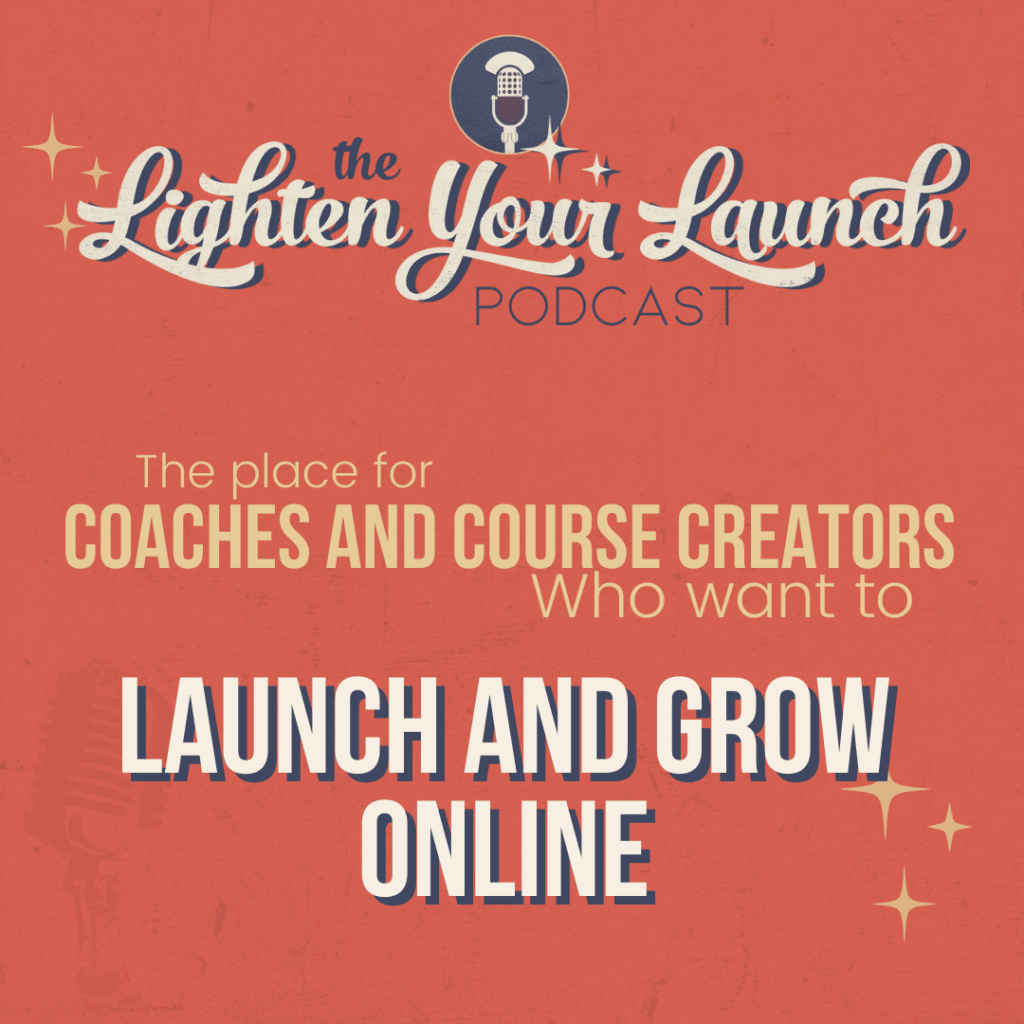
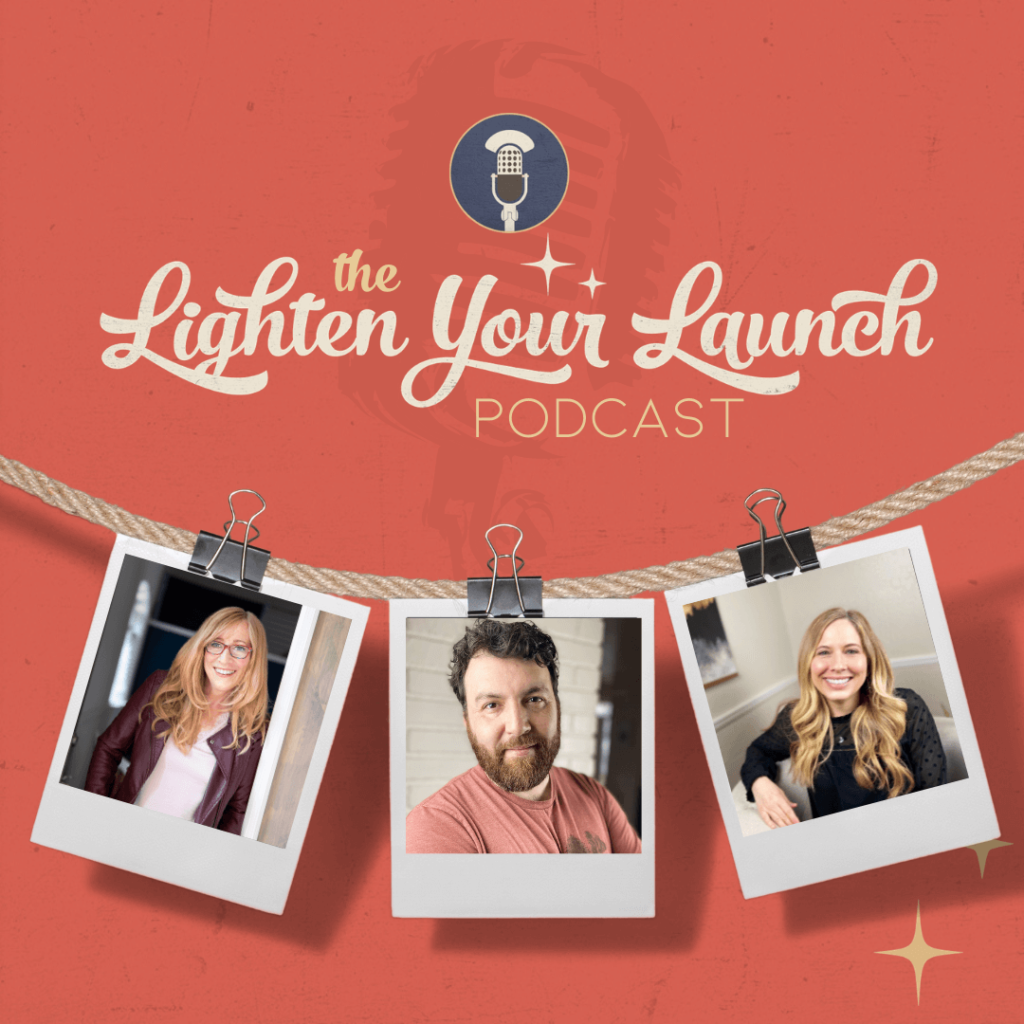


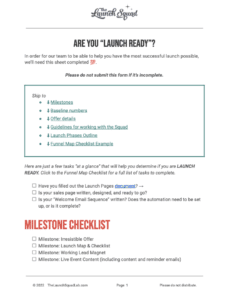
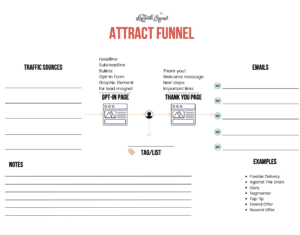
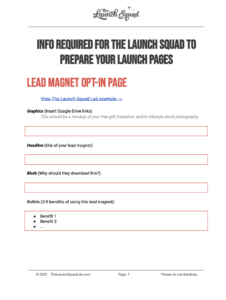
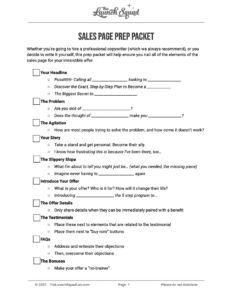
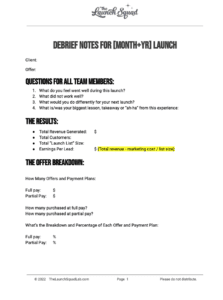
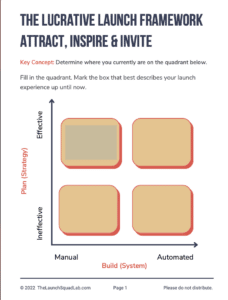
![Marketing Launch Calendar [TEMPLATE]](https://thelaunchsquadlab.com/wp-content/uploads/2023/05/Marketing-Launch-Calendar-TEMPLATE-300x260.png)
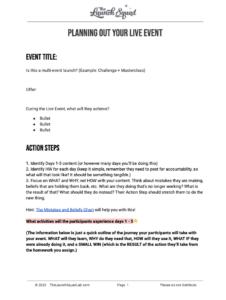
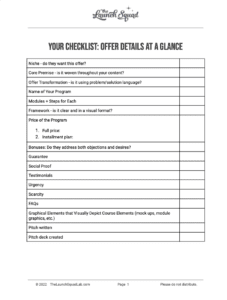
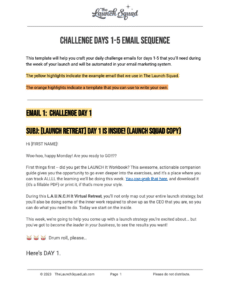
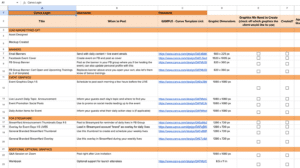
![[Updated] Email Templates for Launch](https://thelaunchsquadlab.com/wp-content/uploads/2023/05/Updated-Email-Templates-for-Launch-223x300.png)
![[REVISED] LS Pitch Script](https://thelaunchsquadlab.com/wp-content/uploads/2023/05/REVISED-LS-Pitch-Script-2023-226x300.png)

